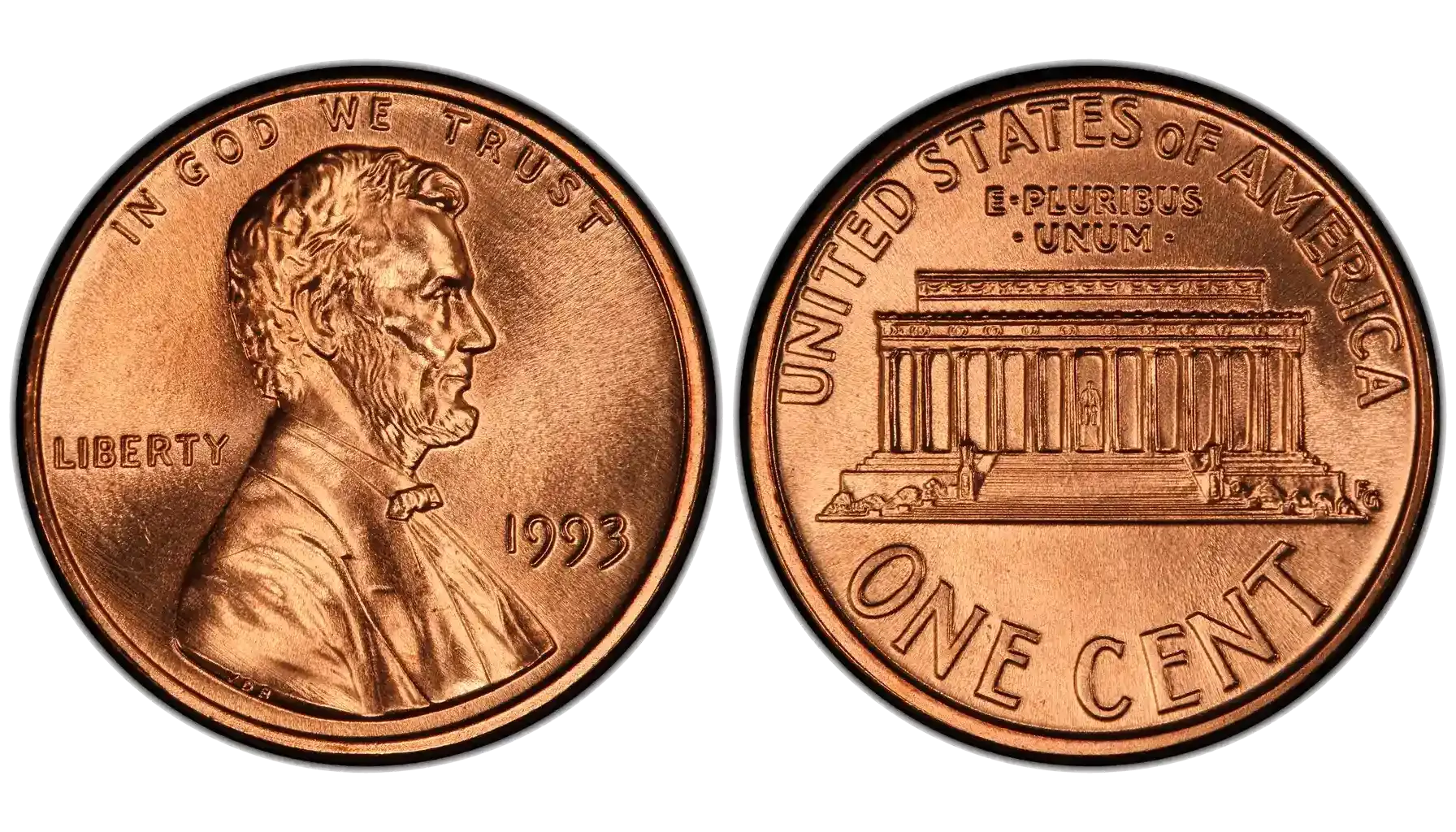Contents:
If you're wondering who is on the 10 dollar bill, it's Alexander Hamilton. Journey through the history of the $10 bill, from the standardized era of 1934 to the early 2000s. Beyond their familiar design, these Federal Reserve Notes hold subtle yet significant differences in series, signatures, and printing origins, influencing their collectibility.
While Laura Bennett's article explores who is on the $10 dollar bill, you can explore the history of the $10 bill to see who's on the $10 bill by yourself, using an AI coin identifier.
1934 $10 Dollar Bill
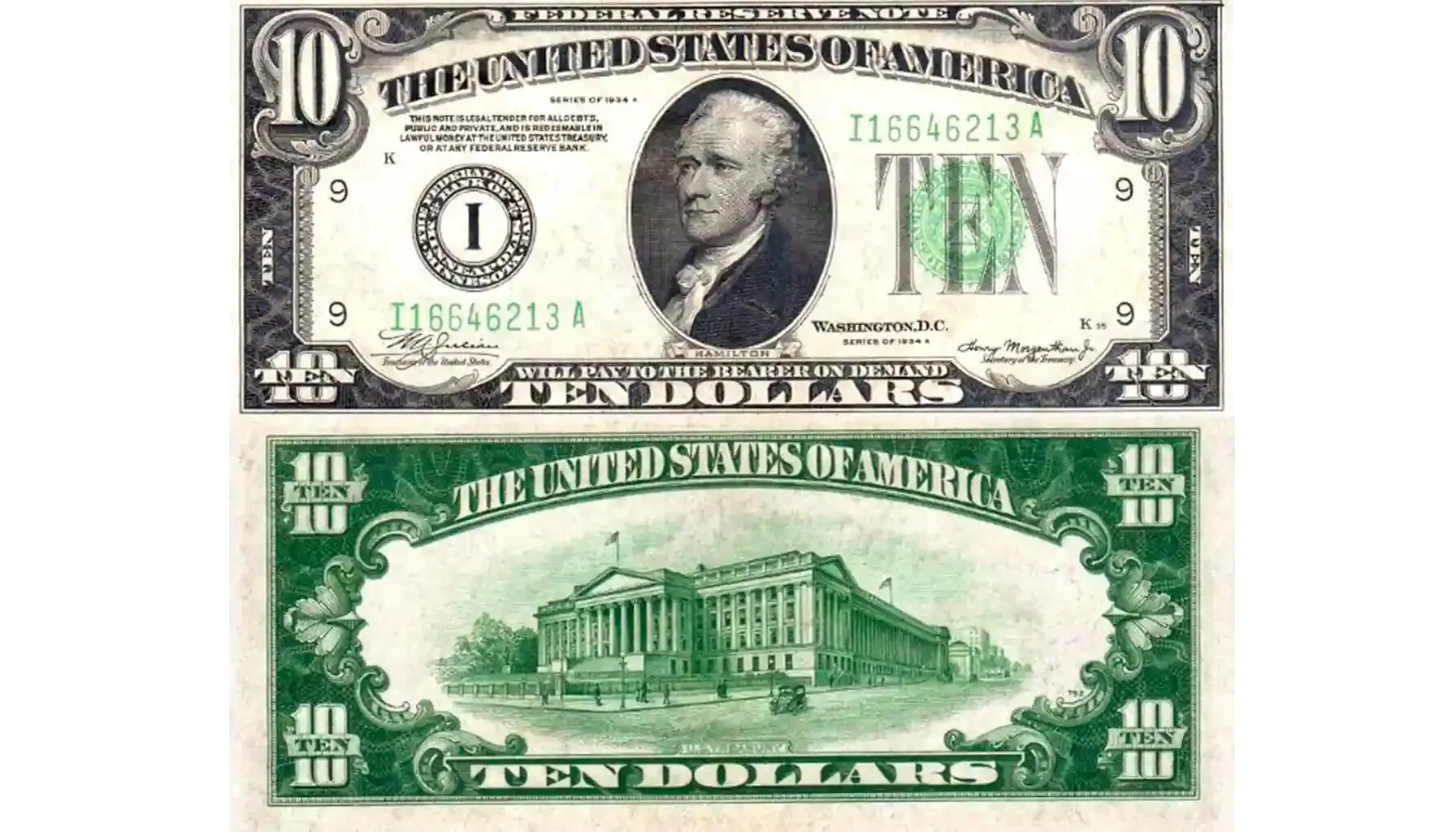
Name | 1934 $10 Federal Reserve Note |
Special Features | Alexander Hamilton portrait, green seal and serial numbers, small size. Different series (A, B, C) exist with varying signatures and Federal Reserve Districts. Star notes are more valuable. |
Mintage (Approximate) | Tens to Hundreds of Millions per district |
Price (USD) | $15 - $500~ |
Historical Context
The history of the 10$ bill, featuring Alexander Hamilton, dates back to a standardized era starting in 1934. This standardization, initiated to reduce printing costs and paper usage during the economic hardships of the Great Depression, marked a departure from the larger "horse blanket" notes of the past.
Series Variations
For instance, the 1934 series often bears the signatures of Henry Morgenthau Jr. as Secretary and William Alexander Julian as Treasurer.
The subsequent 1934A, 1934B, and 1934C series reflect later appointments to these key positions. Furthermore, notes from each of the twelve Federal Reserve Districts (identified by a letter and number on the bill, such as A1 for Boston or G7 for Chicago) were printed, adding another layer of collectibility.
1950 $10 Dollar Bill
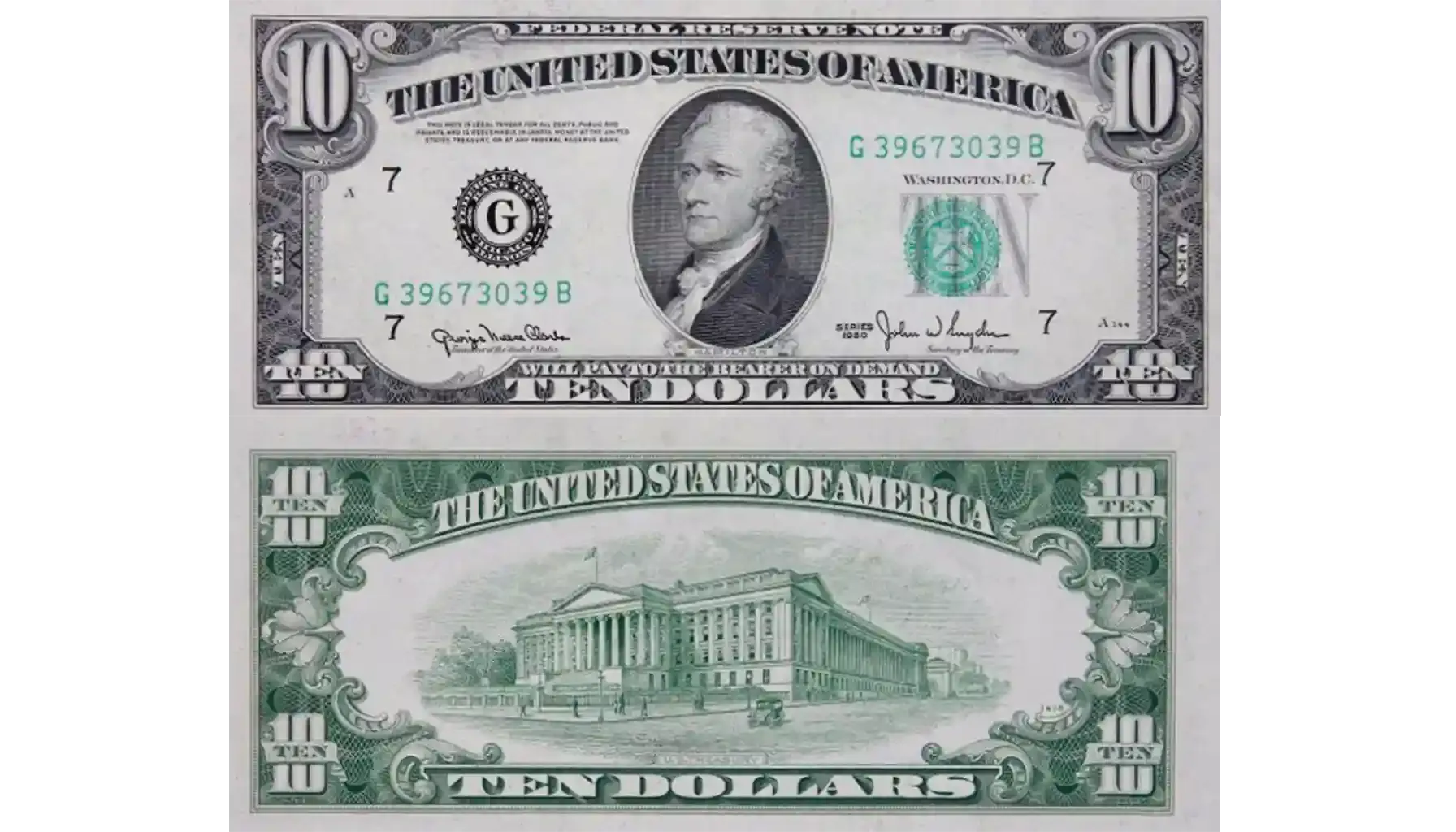
Name | 1950 $10 Federal Reserve Note |
Special Features | Alexander Hamilton portrait, green seal and serial numbers, small size. Different series (A, B, C, D) exist. Again, signatures and Federal Reserve Districts differentiate them. Star notes are collected. |
Mintage (Approximate) | Tens to Hundreds of Millions per district |
Price (USD) | $13 - $750~ |
Historical Context
While many ask what president is on the $10 bill, it's actually Alexander Hamilton, who was not a U.S. president. The 1950 Series $10 Federal Reserve Note emerged in the post-World War II economic boom, a period of significant growth and societal shifts in the United States. These notes facilitated the increasing volume of transactions as the American economy expanded and the middle class grew.
Series Variations
Similar to the 1934 series, the 1950 $10 bills have variations denoted by the letters A, B, C, and D. Each of these featured different pairings of the Secretary of the Treasury and the Treasurer.
1963 $10 Dollar Bill
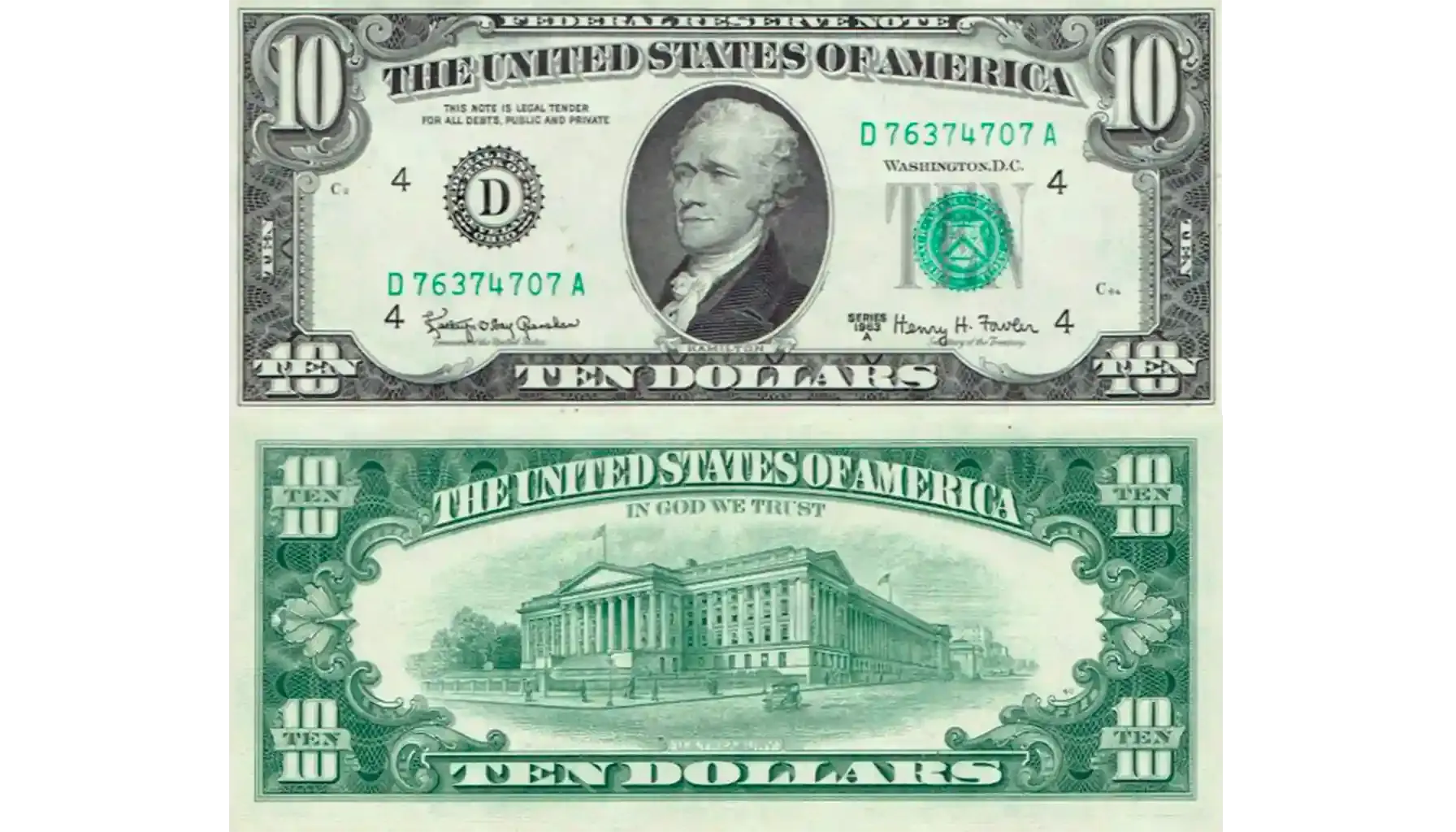
Name | 1963 $10 Federal Reserve Note |
Special Features | Alexander Hamilton portrait, green seal and serial numbers, small size. Features the signatures of Granahan and Dillon. The back of the 10 dollar bill features the U.S. Treasury building |
Mintage (Approximate) | Hundreds of Millions per district |
Price (USD) | $15 - $600~ |
Historical Context
The 1963 Series $10 Federal Reserve Note was issued during a pivotal era in American history, marked by the "New Frontier" and "Great Society". The signatures on the primary 1963 series are those of Kathryn Granahan as Treasurer and C. Douglas Dillon as Secretary of the Treasury, reflecting the Kennedy administration's financial leadership. Some still refer to a 10 dollar bill president, despite Alexander Hamilton not holding that office.
Series Variations
The primary variation within the 1963 $10 bill is the existence of a 1963A. This subsequent features a different signature combination, reflecting a change in Treasury officials with the signatures of Dorothy Andrews Kabis as Treasurer and Douglas Dillon remaining as Secretary.
1969 $10 Dollar Bill
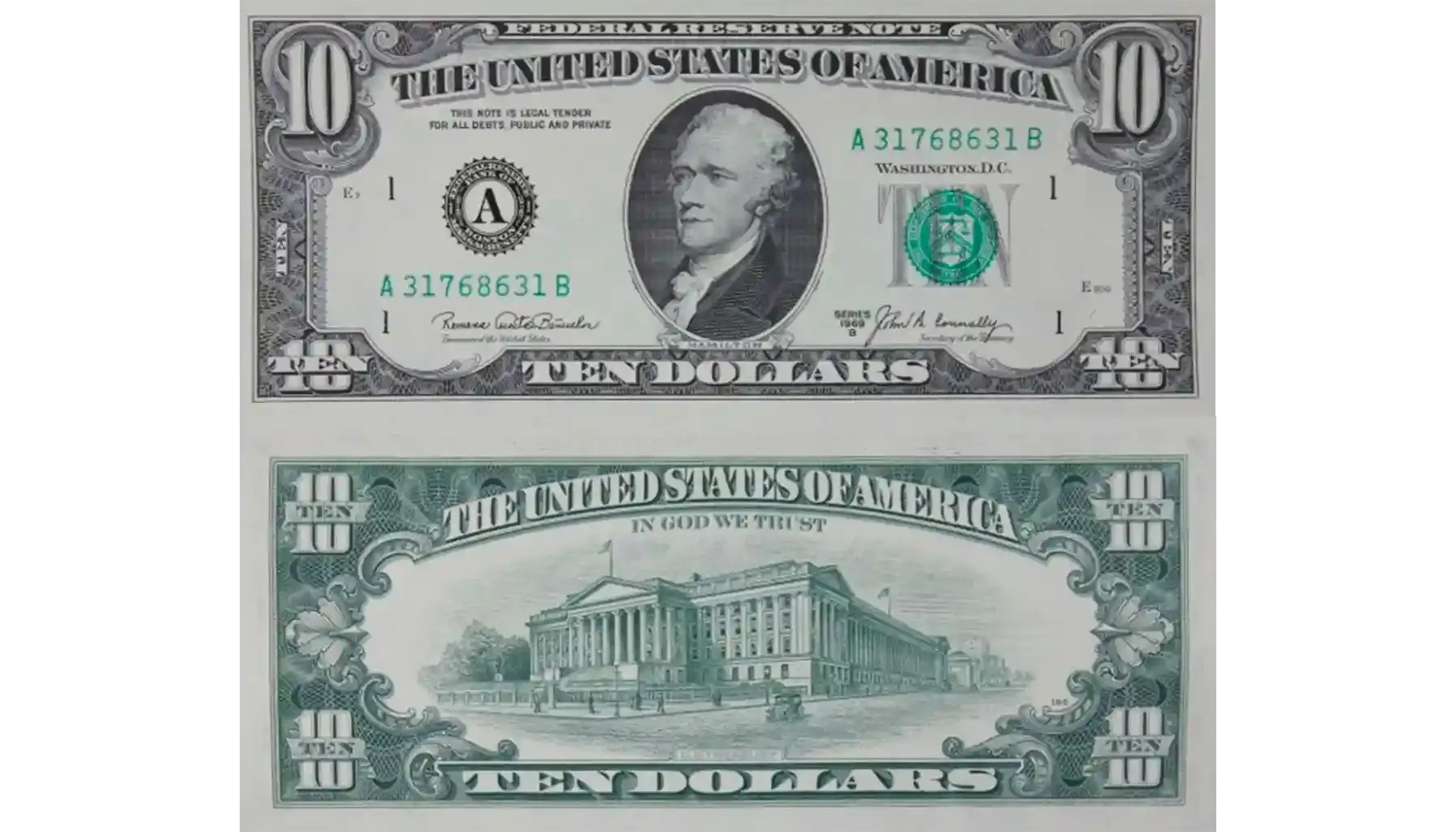
Name | 1969 $10 Federal Reserve Note |
Special Features | Alexander Hamilton portrait, green seal and serial numbers, small size. Features the signatures of Kennedy and Shultz (later Sliker and Connally for Series A). Different series (A, B, C) exist. Star notes are collectible. |
Mintage (Approximate) | Hundreds of Millions per district |
Price (USD) | $15 - $800~ |
Historical Context
The 1969 Series $10 Federal Reserve Note was released during a period of intense social and political upheaval in the United States, including the height of the Vietnam War protests and significant cultural shifts. The initial 1969 series bears the signatures of David M. Kennedy as Secretary of the Treasury and Joseph W. Barr as Treasurer.
Series Variations
The 1969A features the signatures of Paul Volcker as Under Secretary of the Treasury (acting) and Romana Banuelos as Treasurer. The 1969B series features the signatures of George P. Shultz as Secretary and Romana Banuelos as Treasurer.
1974 $10 Dollar Bill
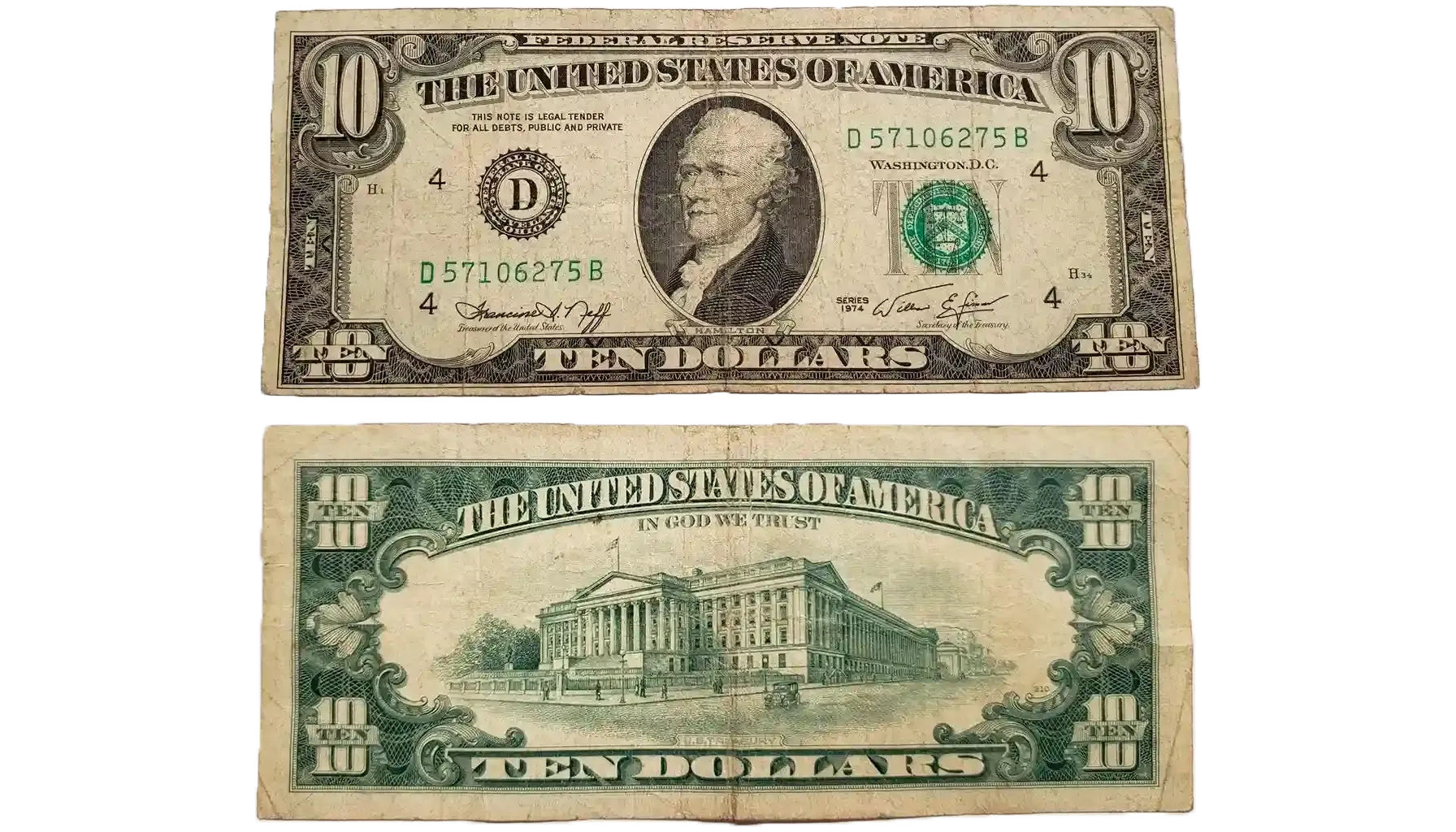
Name | 1974 $10 Federal Reserve Note |
Special Features | Alexander Hamilton portrait, green seal and serial numbers, small size. Features the signatures of Neff and Simon. Different series (A, B, C, D) exist. Star notes exist. |
Mintage (Approximate) | Hundreds of Millions per district |
Price (USD) | $15 - $400~ |
Historical Context
The 1974 Series $10 Federal Reserve Note was issued during a time of significant economic challenges for the United States, primarily the oil crisis and persistent high inflation. The signatures on this series are those of William E. Simon as Secretary of the Treasury and Isabella Casillas Neff as Treasurer.
Series Variations
The 1974 series includes variations denoted as 1974A, 1974B, 1974C, and 1974D, each reflecting different signature combinations as Treasury officials changed. For instance, later featured signatures of other Secretaries and Treasurers.
1977 $10 Dollar Bill

Name | 1977 $10 Federal Reserve Note |
Special Features | The signatures of Blumenthal and Banuelos (later Miller and Roosa for Series A). Different series (A) exist. |
Mintage (Approximate) | Hundreds of Millions per district |
Price (USD) | $15 - $950~ |
Historical Context
The 1977 Series $10 Federal Reserve Note was released as the United States continued to navigate the economic aftermath of the 1970s. The initial series features the signatures of W. Michael Blumenthal as Secretary of the Treasury and Azie Taylor Morton as Treasurer.
Series Variations
An old 10 dollar bill from the 1977 series can be quite collectible, especially if it's a star noteThe primary variation for the 1977 $10 bill is the 1977A, which features a change in both the Secretary and Treasurer, with the signatures of G. William Miller as Secretary and Romana Banuelos as Treasurer.
1985 $10 Dollar Bill
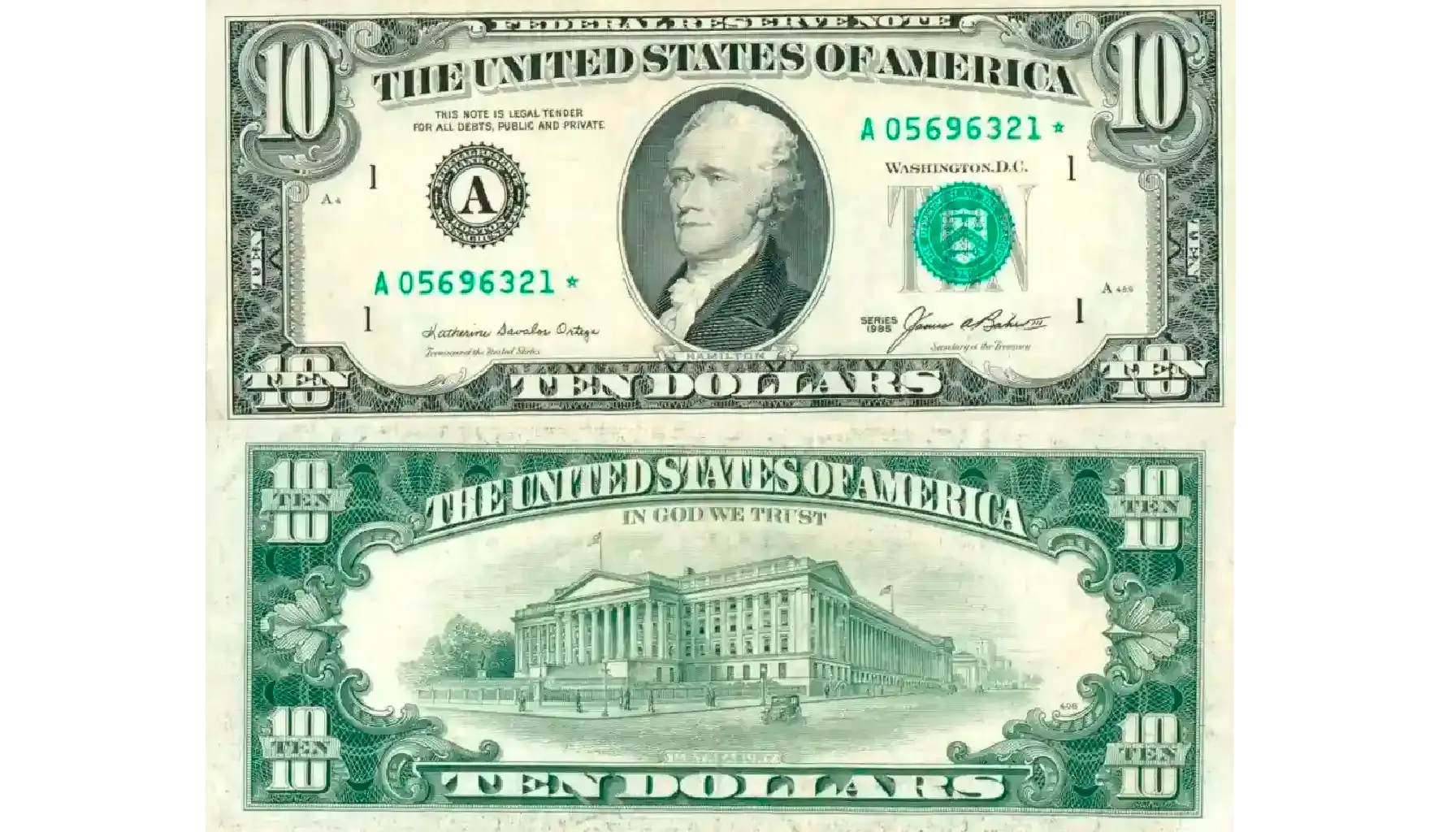
Name | 1985 $10 Federal Reserve Note |
Special Features | Alexander Hamilton portrait, green seal and serial numbers, small size. Features the signatures of Ortega and Baker (later Beryl and Regan for Series A). |
Mintage (Approximate) | Hundreds of Millions per district |
Price (USD) | $15 - $650~ |
Historical Context
The 1985 Series $10 Federal Reserve Note entered circulation during a period of economic expansion in the mid-1980s under the Reagan administration. The initial series bears the signatures of Katherine Davalos Ortega as Treasurer and James A. Baker III as Secretary of the Treasury.
Series Variations
Details on rare 10 dollar bill from 1985 can be discovered through serial number lookups and collector insights. The 1985A represents the main variation, featuring a change in Secretary of the Treasury to Donald Regan. The Treasurer, Katherine Davalos Ortega, remained the same for the 1985A series.
As with all Federal Reserve Notes, these were issued by the twelve Federal Reserve Districts, and star notes were printed for both the 1985 and 1985A across these districts.
1988 $10 Dollar Bill
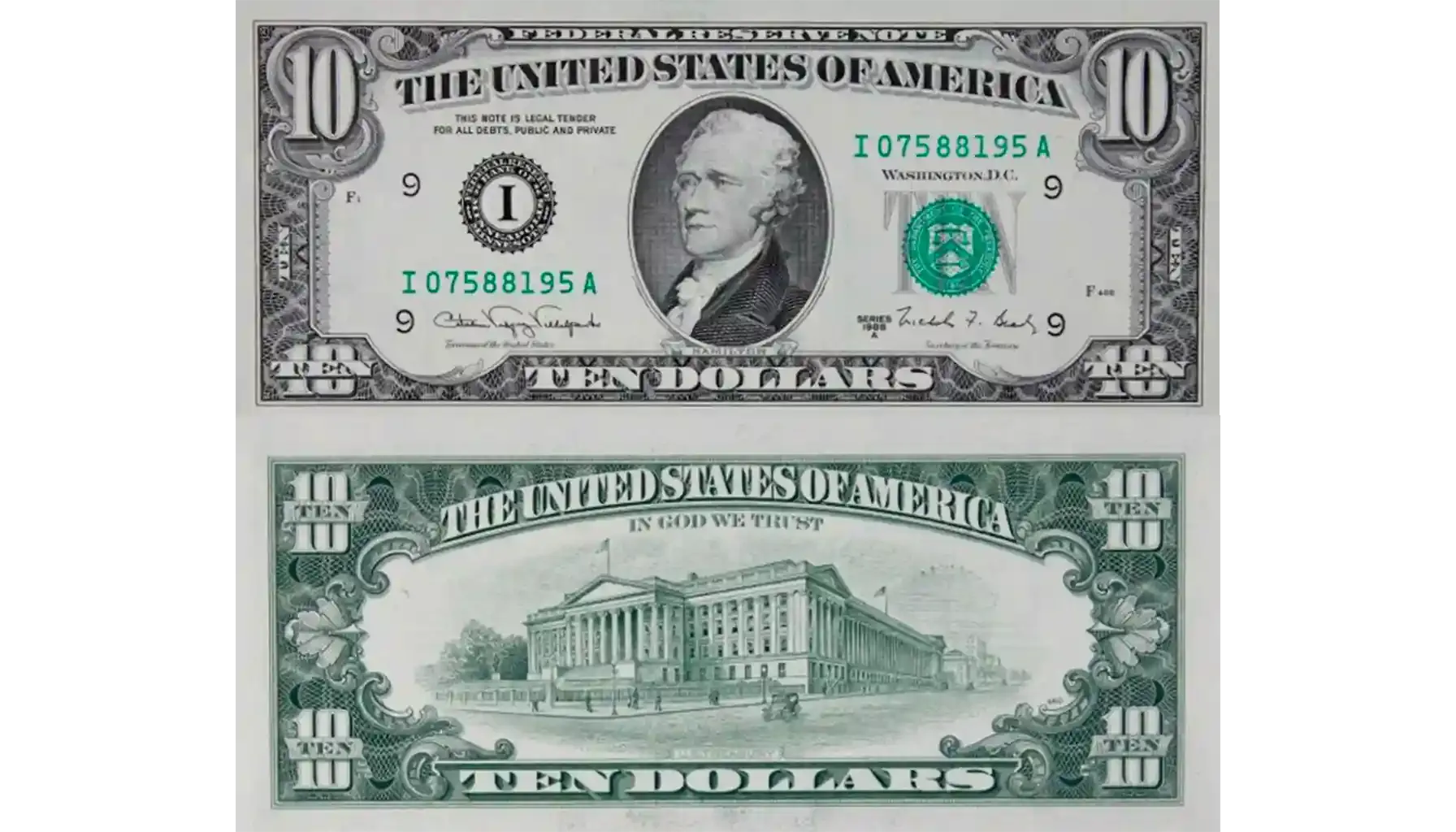
Name | 1988 $10 Federal Reserve Note |
Special Features | Alexander Hamilton portrait, green seal and serial numbers, small size. Features the signatures of Villalpando and Bentsen (later Brady for Series A). |
Mintage (Approximate) | Hundreds of Millions per district |
Price (USD) | $15 - $500~ |
Historical Context
The 1988 Series $10 Federal Reserve Note was introduced towards the end of the 1980s, a decade marked by increasing globalization and technological advancements. The initial 1988 series features the signatures of Catalina Vasquez Villalpando as Treasurer and Lloyd Bentsen as Secretary of the Treasury.
Series Variations
The primary variation for the 1988 $10 bill is the 1988A series. This reflects a change in the Secretary of the Treasury to Nicholas F. Brady, while Catalina Vasquez Villalpando remained as Treasurer.
As with all Federal Reserve Notes, these were issued by each of the twelve Federal Reserve Districts, and star notes were produced for both the 1988 and 1988A series across these districts.
1995 $10 Dollar Bill
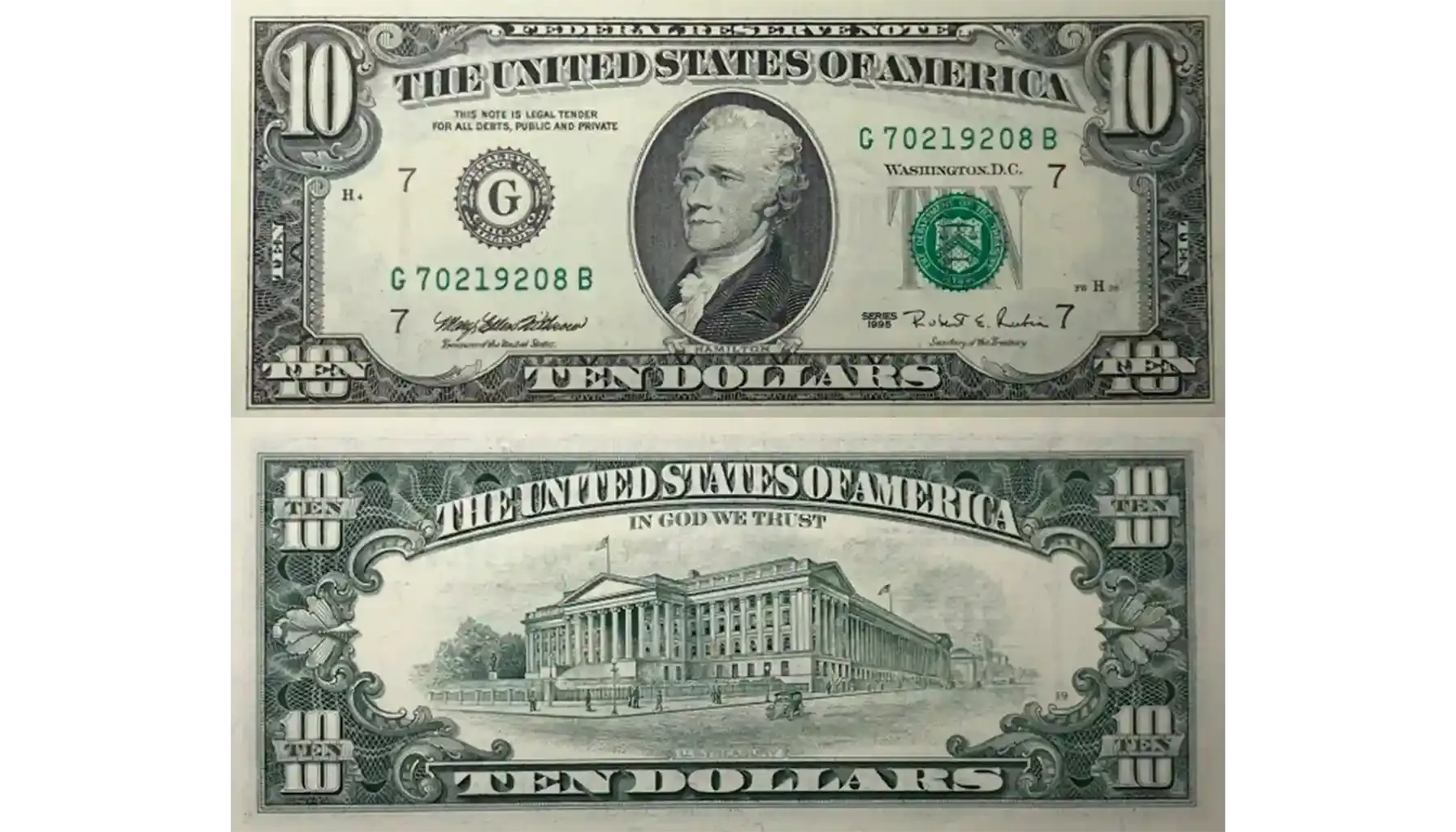
Name | 1995 $10 Federal Reserve Note |
Special Features | Alexander Hamilton portrait, green seal and serial numbers, small size. Features the signatures of Rubin and Withrow. No series letter. Star notes exist. |
Mintage (Approximate) | Hundreds of Millions per district |
Price (USD) | $15 - $480~ |
Historical Context
The 1995 Series $10 Federal Reserve Note was released during a period of significant economic prosperity in the mid-1990s, fueled by technological innovation and a booming stock market. This series features the signatures of Robert Rubin as Secretary of the Treasury and Mary Ellen Withrow as Treasurer.
The Federal Reserve under Alan Greenspan navigated monetary policy to maintain stable growth and low inflation.
Series Variations
Collectors often perform a $10 dollar bill serial number lookup to identify rare varieties and assess value. The 1995 series is notable for initially lacking a letter. Later printings within this year did include letters starting with "A," indicating subsequent print runs with the same signatures.
1999 $10 Dollar Bill
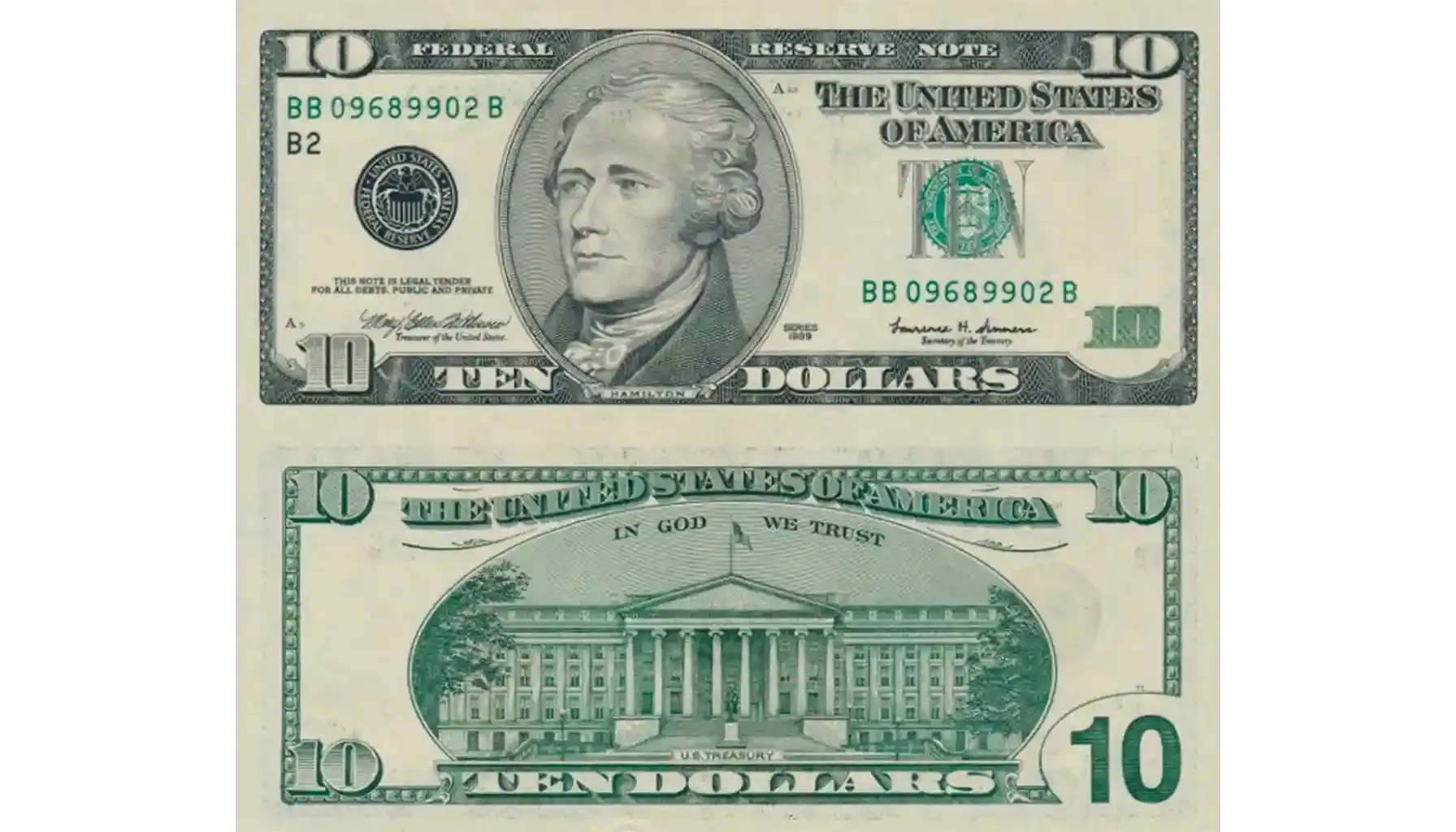
Name | 1999 $10 Federal Reserve Note |
Special Features | Alexander Hamilton portrait, green seal and serial numbers, small size. Features the signatures of Summers and Withrow (later Robert E. Rubin and Lee Ann Aultman-Aney) |
Mintage (Approximate) | Hundreds of Millions per district |
Price (USD) | $15 - $700~ |
Historical Context
The 1999 Series $10 Federal Reserve Note was introduced at the cusp of the new millennium, a time of rapid technological advancement and a continued strong economic climate. The initial features the signatures of Lawrence Summers as Secretary of the Treasury and Mary Ellen Withrow as Treasurer. Later in the year, a signature change occurred to Robert Rubin (returning as Secretary) and Lee Ann Aultman-Aney as Treasurer.
Series Variations
The primary variation within the 1999 lies in the signature combinations. The initial printing features Summers and Withrow, while a later printing features Rubin and Aultman-Aney. Like the 1995, the 1999 notes initially lacked a letter, with subsequent printings including series letters starting with "A."
2003 $10 Dollar Bill

Name | 2003 $10 Federal Reserve Note |
Special Features | Alexander Hamilton portrait, green seal and serial numbers, small size. Features the signatures of Snow and Marinuzzi. Different series (A) exist with the same signatures. Star notes are available. |
Mintage (Approximate) | Hundreds of Millions per district |
Price (USD) | $15 - $350~ |
Historical Context
The 2003 Series $10 Federal Reserve Note was released in the early years of the new millennium, a period marked by the aftermath of the dot-com bubble burst and the economic adjustments that followed. This series features the signatures of John W. Snow as Secretary of the Treasury and Rosario Marinuzzi as Treasurer.
Series Variations
The 2003 series includes a 2003A variation, but notably, both the 2003 and 2003A feature the same signatures of Snow and Marinuzzi. As with all Federal Reserve Notes, these were issued by the twelve Federal Reserve Districts, and star notes were produced for both the 2003 and 2003A across these districts.
To sum up, every Alexander Hamilton 10 dollar bill from 1934 to the early 2000s features his portrait. Collectors invested in numismatics often perform a $10 dollar bill serial number value lookup to assess the rarity and potential worth of certain notes. These subtle differences, including signatures, and printing origins, significantly influence their collectibility.

